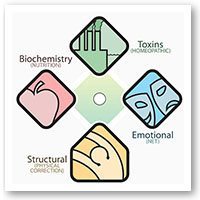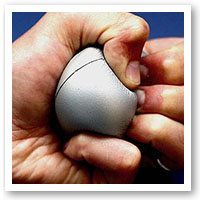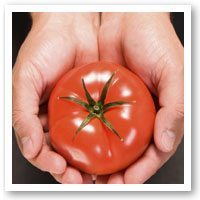Posts
What attracts us to our loved ones is what ends up repelling us.
/in Psychotherapy /by Andrew Relationships are funny things. No two are alike and yet, at the same time, all share many similarities as well. One such similarity we all share in are times of frustration with our loved ones.
Relationships are funny things. No two are alike and yet, at the same time, all share many similarities as well. One such similarity we all share in are times of frustration with our loved ones.
I often speak with couples having hard times in their relationships or marriages and they often sound quite clear on what their partner is doing that is flaring up their frustrations. At some point I always ask what it was that first attracted them to their partners and what they initially fell in love with and, like clock work, their answers reveal that the things they loved and cherished in each other, as they fell in love, were the same qualities that frustrate them now.
For example, seven years ago John fell in love with Louise; he loved how care free she was and how spontaneous and in the moment she could be. He was much more ordered and practical and was more used to a life well planned out, a life without too many surprises. John was attracted to those qualities in Louise, which he himself would have liked to possess.
Louise, on the other hand, fell in love with John’s solidity. He was grounded, stable and practical, all qualities which she was attracted to which she wasn’t accessing in herself, and qualities which were needed to balance her out.
Now fast-forward seven years. John is frustrated with Louise and needs her to change. In his mind she is inconsistent with her commitments and responsibilities and he is angry that he can’t rely on her to do things when he feels they need to be done in the home. As a result he is feeling unsupported and let down. He wishes that she could be better planned and fly less by the seat of her pants.
Louise, on the other hand, is feeling squashed and forced to live in a way that doesn’t suit her style of being. She wants John to ease up and take more risks in life. She is bored with the blandness of their relationship and wants more excitement with him.
This is typical example of how the qualities that attract couples end up eroding the warmth they have for each other. As a result of this, the qualities which partners fell in love with often become the same qualities they try to change about each other.
In my line of work as a couple’s counsellor, I often find myself saying to one or both partners, “That’s not going to happen”, or “He is not going to give you that”. Couples are often startled to find that I don’t roll up my sleeves and help them change their partners.
When couples find themselves in the situation of trying to change their partners so they feel better about themselves the role of therapy is to interrupt this trance rather than empathise and support with their needs to change the other.
The undeniable truth with relationships is that those we love are also our burdens. Too often we just want to take the parts that work for us right now and leave the rest of them in the bottom drawer.
For many couples, the magic bullet to getting back on track with their marriage and finding more harmony again is to be able to look at their partner and say, “this is who they are, and this is who they will continue to be”. Once this is acknowledged, a different and scarier reality is seen by each of them.
At this point couples often see that they struggle to love each other for who they truly are; eventually this leads to a more useful and practical question to ponder, and that is “How do I learn to live with this person for who they truly are, while living with who I truly am too”?. And the answer to this is, of course, will be different for us all.
Teenager boys – Anger, powerlessness and rage.
/in Psychotherapy /by Andrew Teenage boys face many challenges as they navigate adolescence and one of the biggest is how they navigate their emerging anger and aggressions.
Teenage boys face many challenges as they navigate adolescence and one of the biggest is how they navigate their emerging anger and aggressions.
Often, as a teenagers testosterone levels increase and biologically they are faced with an increase in their aggression and anger; how well they have been set up through their life to navigate these often primal and powerful feelings will determine whether they assimilate this energy as an adult ; either in a positive and assertive way, or whether they become stuck and powerless or rage-full and uncontrolled.
The Primal disconnection.
There are many ways in which a coming of age male learns to disconnect from their anger. Helping them to understand how this came about and facilitating a safe and constructive way of using it, allows new choices for them which ultimately has them once again accepting their anger and being able to assert themselves to get what they need in life.
So how is it that boys disconnect from their anger in the first place?
Some of the main ways this disconnect occurs comes from their own experiences of anger, how they experience anger from others and what beliefs come from this.
One belief I face often from teenage boys is that anger is wrong, or not allowed.
If a child has experienced their parents fight in destructive and even violent ways, or if the child has been victim of misplaced anger or rage from another, then the boy often creates a rule in himself that will ensure such situations do not occur again in their own life. This rule is generally “ anger is bad, if I become angry then I am bad”, or “ I must stay away from anger because it’s dangerous”. Such a belief underpins their anger and stops them from accessing it. Even when the anger is accessed they will typically move away from it quickly to avoid, in their estimation, “being bad”, or that they feel suddenly “too dangerous”. The result of such a block is that the boys lose something of their own personal power. So in the school yard, this boy will end up conceding in all manner of ways to the boys who are in full charge of asserting their will and their needs. Ultimately this results in a teenager who struggles to both ask for what he needs and to stand up for what he believes.
The flip side to this block can be like a rage filled pressure cooker where the boys anger, although not allowed, grows and grows until a single instance brings all the anger out at once. Typically this is experienced as uncontrollable rage and the boy, rather than feeling in control with his anger, feels powerless to his anger, which further confirms their belief that anger is bad. The more this cycle continues the worse the rage gets and the stronger their belief anger is bad.
In either case, the way forward is in helping the teenager experience their anger in new ways. In therapy, talking about the rules and beliefs of their anger is often a starting point but its typically not enough. What I’ve often found is that the teenager needs to have an actual experience of their anger that produces a different and positive result, so they can start to understand anger’s usefulness when used assertively.
This approach requires the therapist to be in a solid relationship with the young man while they access their anger, to be able to truly hear the needs under then anger, to demonstrate that their anger can be held and that they are still accepted once their anger arises. Being able to provide this setting allows quite a sudden and powerful reframing of anger and typically frees the teenager to be in control of his own anger.
Once it is achieved the teenager has some quite predictable changes in their life. They feel more comfortable with peers and less focused on pecking orders within social groups. They feel less anxious in themselves and become more expressive in social settings, and they are also free from recurring angry thoughts, which were previously caught up in their blocked anger.
What I find most interesting about this process is that once they have finally experienced their anger in more positive ways, within 1 or 2 sessions they share that they do not need to return and that life is now somehow back on track.
Naturopathy and Weight Management
/in Nutritional Medicine /by Andrew There are more deaths from obesity than malnutrition. It is estimated that 63% of adults in Australia are now overweight or obese, and 25% of children. These figures are on a steady incline, as are all the complications that come with it.
There are more deaths from obesity than malnutrition. It is estimated that 63% of adults in Australia are now overweight or obese, and 25% of children. These figures are on a steady incline, as are all the complications that come with it.
With so many “health experts” giving advise on how to eat, it can get slightly overwhelming knowing whose advise you should actually take, and if the latest fad diet is the one that will work for you. Weight loss can be individual at times, as there are other factors that may be hindering you, such as insulin resistance, underactive thyroid and hormonal imbalances.
Your naturopath will take a thorough case history, delving into your personal history to come up with the necessary dietary and lifestyle amendments, as well as any needed supplementation.
Will I have to drink water and eat mung beans all day?
No! Food is one of life’s greatest pleasures, I think it’s important to not think of it as a diet, but think of it as a healthy lifestyle change. It’s not just about losing weight and keeping it off, it’s about feeding your body with nourishing and supportive foods, so you feel better and improve your life expectancy by lowering your risk of so many other illnesses.
Conditions associated with obesity?
So many of today’s deadly diseases have obesity as a causative factor,. Obese people have a 50-100% increased risk of death from all causes, most of the risk if from the following;
- Hypertension
- High Cholesterol
- Atherosclerosis
- Type 2 Diabetes
- Cancer
- Infertility
- Back pain
Acupuncture for Neck and Shoulder pain
/in Acupuncture /by Andrew Neck and shoulder tension is one of the banes of modern life – when severe, the pain often extends down the arms and also can lead to headaches and jaw stiffness. It can really limit your life. But you don’t have to be stuck with it!
Neck and shoulder tension is one of the banes of modern life – when severe, the pain often extends down the arms and also can lead to headaches and jaw stiffness. It can really limit your life. But you don’t have to be stuck with it!
Acupuncture is great for melting those knots. Within 4-6 treatments we usually see substantial relief, with the hard areas becoming much looser. The time taken for this to happen depends on how long the tension has been there for, and how severe it is.
The treatments are very gentle – Acupuncture use extremely fine needles that you barely notice, plus moxibustion, a form of herbal heat treatment. The combination works really well in relaxing muscles, especially in the shoulders and neck
During a treatment, our Acupunctuirists uses a combination of Acupuncture points specifically targeted at any imbalance underlying the muscle stiffness, as well as local points to bring fast relief. We also look at lifestyle measures to help prevent the problem recurring.
Tara is a Registered Acupuncturist with many years’ experience in treating neck and shoulder issues. Health-fund rebates are available for Acupuncture treatments.
What is Neuro Emotional Technique?
/in Neuroemotional Technique N.E.T. /by Andrew Neuro Emotional Technique or NET is a simple mind-body stress reduction intervention aimed at improving behavioral and physical problems, such as in chronic injuries, subluxations, pain, worry, anxiety, depression, etc. It was developed by an american Chiropractor, who like all Chiropractors would regularly see patients where chiropractic adjustments aren’t enough to help them with chronic pain, while also understanding that stress changes our physiology and affects our structure, and hence can lead to musculoskeletal problems.
Neuro Emotional Technique or NET is a simple mind-body stress reduction intervention aimed at improving behavioral and physical problems, such as in chronic injuries, subluxations, pain, worry, anxiety, depression, etc. It was developed by an american Chiropractor, who like all Chiropractors would regularly see patients where chiropractic adjustments aren’t enough to help them with chronic pain, while also understanding that stress changes our physiology and affects our structure, and hence can lead to musculoskeletal problems.
Its common for a memory to elicit a physiological response in us, such as the example where simply thinking of a food we really enjoy can make us salivate. That occurs more strongly when the memory has some stress associated with it. This physiological response is known as ‘conditioning’, and the stronger the emotion, the stronger the conditioning. Over time this conditioned response will lessen and eventually subside, and this is the normal process of ‘extinction’. Although, if at the time of conditioning the body is not in a balanced state then the process of extinction does not take place. This results in an aberrant response to future similar stimulus. A response that once was appropriate is now unnecessary and even excessive.
An example is someone who almost drowned will be fearful of water initially. They will commonly experience some of the same physiological responses they did at the time of the near drowning, such as heart racing, pupils dilating, sweaty palms etc., when they are in water or even think of being in water. For most people this reaction subsides, but for a few they continue to have this response, which is no longer necessary or appropriate. This can become a problem as it impacts negatively on their life. This lack of extinction can also be a problem in relatively minor day-to-day experiences such as public speaking, confrontations, interviews, flying etc. The impact of this may be very obvious in day to day life, such as the two examples given, but commonly it impacts on us in less obvious ways, and results in chronic pains or illnesses.
NET is a treatment that allows your body to go through that natural process of extinction (which it has failed to do) and hence reduce any of those inappropriate physiological reactions. NET differs from counseling, as it doesn’t involve talking it out, it is a tool that removes any blocks to the bodys natural healing ability and as such allows the body to heal itself more effectively. It can be used in the course of a chiropractic treatment to assist the structural correction, or it can be utilised as the sole treatment in a session to work on specific emotional reactions or blockages that the patient wants to address.
Achieving Wellness for Life
/in Nutritional Medicine /by Andrew
On his 100th birthday, Eubie Blake said “If I had of known I was going to live this long, I would have taken better care of myself.”
It is that time of year when good intentions have been set and resolutions made. How have you gone so far? If you have found it too difficult to stay motivated or on track for just a few short weeks, then perhaps it is time to simply get back to the basics of good health. Otherwise, how can you sustain good health for the long term? By following some simple guidelines, most of us can achieve wellness for life.
7 Steps to Wellness
Fad diets are out! Sustainable, healthy eating is truly the best way to achieve your goal of vitality and wellness for the long term. It is easy to eat well and be healthy following these key steps :
- Include protein-rich foods in each meal or snack, including fish, poultry, lean meats, eggs, dairy, tofu, and tempeh. Remember fresh is best.
- Enjoy a minimum of three cups of fresh vegetables per day to help increase long-term health and vitality. Aim to have a rainbow on your plate to ensure good antioxidant intake and seasonal variety.
- Enjoy a minimum of two pieces or one cup of fruit per day.
- Starchy carbohydrates should be kept at a minimum, with one to two small serves each day. These include cereals, pasta, bread and rice. Where possible choose low glycaemic index options such as wholegrain varieties.
- Include nuts, seeds and healthy oils daily. Enjoy up to two tablespoons of healthy oils such as olive oil, macadamia oil or flaxseed oil, and ¼ cup or a small handful of nuts and seeds. Nuts and seeds can also provide protein and other nutrients, such as selenium from Brazil nuts.
- Ensure you are well hydrated. Enjoy at least eight glasses or two litres of pure water per day. Use natural flavourings such as fresh lemon, lime, mint or watermelon instead of opting for soft drinks. Reduce caffeinated beverages to one to two per day, and minimise alcohol intake.
- It can be a challenge to maintain a perfect diet 100% of the time. Allow yourself a freedom meal once a week. This will keep your life-long wellness program achievable, realistic and enjoyable.
Plan to Play, Be Active, Relax and Enjoy:
Achieving wellness can require a bit of juggling initially to maintain balance in all areas of your life; and consistently eating well is only one facet of your wellness plan. It is important to exercise regularly to support your physical and mental wellbeing. Aim for 30 minutes of light to moderate exercise most days of the week. Find an activity that you enjoy doing and stick with it. Relaxation activities such as yoga, spending time in nature, playing with pets or meditation can also help increase the feel good chemicals in your brain and help you to de-stress. Fun social activities, such as sharing a meal or having a laugh with friends and family are also an important aspect of a happy, balanced life. Speak to your Practitioner for advice on setting Wellness goals and monitoring your progress towards health and vitality.
Maintain Your wellness with Key Supplements:
Research shows key natural supplements can complement your wellness diet and lifestyle program such as:
- A high quality fish oil to provide daily omega-3 for a healthy heart, supple joints and healthy nervous system.
- A high-strength probiotic can help to maintain the right balance in your digestive tract, as many lifestyle factors can throw this balance out. Probiotics can differ depending on strain and species so come in and talk to your Practitioner today to find the right probiotic to help you achieve Wellness.
- A daily multivitamin and mineral formula to fill any nutritional gaps that your diet doesn’t fulfil.
- A good quality antioxidant formula to support healthy ageing and reduce the risk of developing chronic disease. Resveratrol is a flavonoid commonly found in red wine and is a powerful antioxidant that may assist in preventing age-related diseases.
Resveratrol also supports cardiovascular health and has anti-inflammatory properties that are beneficial in any Wellness program.
Stress and your body, part 2.
/in Chiropractic /by Andrew Now, after reading Part 1 in last months newsletter, you may have a better understanding of how readily our body reacts and changes in response to stress. These changes will often occur without us having any awareness of them, but there are many other changes that occur that that we can feel. Many patients present to me with various aches and pains, that very often have an underlying cause of stress. When we are dealing with stress our body reacts in certain predictable ways. There are 3 muscles that will always tighten in response to stress. They are your diaphragm, your upper Trapezius and your Suboccipital muscles.
Now, after reading Part 1 in last months newsletter, you may have a better understanding of how readily our body reacts and changes in response to stress. These changes will often occur without us having any awareness of them, but there are many other changes that occur that that we can feel. Many patients present to me with various aches and pains, that very often have an underlying cause of stress. When we are dealing with stress our body reacts in certain predictable ways. There are 3 muscles that will always tighten in response to stress. They are your diaphragm, your upper Trapezius and your Suboccipital muscles.
Your diaphragm is a sheet of muscle that sits like a dome and divides your internal body in half. It sits below your lungs and heart and above the rest of your organs, and is important in breathing as it moves down to help your lungs draw breath in and up to help push air out of your lungs. When it is tight it is not able to move down and this results in feeling short of breath. As it is attached to structures on the inside around the level of the lower ribs, any tightening of the diaphragm can pull on these structures and often create a twist in that area. This can result in pain in the back, along the spine, around the ribs, and sometimes even pain on breathing.
The upper Trapezius muscle sits across the top of your shoulders and up into the lower neck, as it tightens it will pull the shoulders up and pulls the neck down into the shoulders. This affects your posture and will create discomfort in your shoulders, between your shoulder blades and also your neck. It can also cause a pinching of the nerves in your neck resulting in numbness or a tingling or pins and needles sensation in your hands or fingers.
The Suboccipital muscles are short muscles that join the back of your skull to the upper neck. Any tightness in these muscles will cause your head to tilt back. They can give you pain in the upper neck and in the back of the skull. Tightness in these muscles together with the Trapezius muscles creates poor posture and stiffness running from the skull to your shoulder blades, resulting in neck and shoulder pain as well as headaches. Sustained tightness and resulting poor posture in this area can often result in achiness in your upper arm.
Another common reaction to stress is clenching or grinding your teeth. Apart from this being damaging to your teeth, it causes very tight jaw muscles. This in itself can give you pain around the jaw which can feel like a headache. These tight muscles will also affect the upper neck and temples due to where they attach, and cause neck pain and stiffness and headaches.
Stress is a part of every persons life, and it can be positive, such as it being a motivator, but it can also cause problems. Just like everything in life there needs to be balance for there to be health and wellness. Stress can be balanced by exercise and relaxation, so it is important to find forms of exercise and relaxation that work for you, and incorporate that into your daily life.
Neuro Emotional Technique can be effective with early life upsets and traumas?
/in Neuroemotional Technique N.E.T. /by AndrewAs much as there has been a prolific amount of neuroscientific research into how the brain influences and controls memory, there has been a growing amount of research that supports the likelihood that memory is actually stored at a cellular level within the body. This finding has some exciting implications for how we think about changing, growing and healing as people, especially with respect to early or childhood trauma or abuse.
Memory Making
Research shows that, on average, a child can start to make real and accessible memories from around the age of 2 years old. This is because at this time the infant can start to think and communicate with the world, and think with themselves using basic language and thinking, a sense of meaning or story can start to be encoded within their experiences and therefore their memories.
It was previously believed that prior to this time in an infant’s life, memories were not actually formed due to the infant not yet possessing these basic cognitive assets. Research now shows that prior to 2, infants still hold memories but they are encoded differently. Rather than having images, or sounds or stories attached to their memories, they seem to be simply stored at a cellular level of the body as emotions. Simply put, the first 2 years of an infant’s memories are not memories in the sense that we understand typical memories to be, they are more like emotional memories.
Memory recall
We all know that certain stimuli can trigger specific memories. The smell of freshly baked bread can remind us of an earlier time where Mum used to make bread, or the smell of petrol can remind us of Dad’s work shed. Typically these memories are encoded in the form of pictures, sounds and often feelings. But our pre-cognitive memories are also triggered by events in our every day life too. The challenge here is that when these memories are accessed and recalled they do not come back as memories from the past, they can be experienced as emotions that seem to be from the present moment. In other words, because there is no story, picture or cognitive concept of the memory that links to their triggered feelings, often a person will not realise they are in fact recalling a memory, and will in fact think that the feeling Is emerging from something that’s happening right now In their environment. This point becomes increasingly important if there was early trauma in a person’s life, as these memories can come back as very powerful and unwanted experiences.
An example could be when a baby girl was given out for adoption at 6 weeks old. The baby intuitively stores their sense of grief and abandonment at a cellular level but with no cognitive story or meaning attached to the feelings of abandonment, it then becomes difficult for her to understand where these feelings come from when they are triggered later in adult life.
As an adult, if she’s faced with a situation where she has to say goodbye to a work colleague who is moving on to another company, she can suddenly become overcome with a disproportionately large amount of grief and sense of abandonment. In this moment she thinks that the current circumstance is the cause of their grief and abandonment, yet in reality the current circumstance is just a trigger for the very young and powerful cellular memory of being abandoned by her biological mother. For this person, there is no link in their mind between the emotion of abandonment and the original event of being abandoned.
Understanding, resolving and releasing these very early emotions can be difficult due to the fact that there is no cognitive memory involved. The person cannot think back and link their emotions to very early events and understand how and why they are overcome with powerful feelings.
Cellular memory transmission
Over the last 30 years, many researchers have shown that our early memories go back even further than birth!!!
As far back as the 1970’s, there has been research into the fact that a fetus can pick up on, and respond to, the emotions and the intentions of the mother carrying the baby, and those close to her, such as the father and extended family. Research suggests that both babies and fetuses are porous to other people’s emotions and actually take these on as their own. For example, if a mother, while pregnant, is angry and resentful at the fact that she feels too young to be a mother, the fetus actually stores the memory of feeling unwanted at a cellular level. Later in life the person has no possible way of connecting up the reason why they continue feel so unwanted and disconnected from others. Once again, the person thinks that what they experience as an adult now is a feeling caused from something occurring now, without seeing what they experience is actually an early stuck cellular memory being recalled.
In such instances, NET (Neuro Emotional Technique) gets powerful results in not only accessing these emotions, but in allowing the body to process them and let them go. NET works with the body’s natural intelligence and energy flows to pin point the times when the emotional memory was stored in the body’s cells, as well as where in the body the emotion primarily resides, and then quickly and painlessly helps the client to process and let it go with through the use of acupuncture and meridian points. The process is often so powerful that unwanted and life long patterns of behavior suddenly stop without the client having to try to change. The cycle in the mind body connection is broken and the person just moves on.
What types of early trauma can NET assist with?
- Alcoholic or addicted parents when a child was young
- Early violence or parental neglect
- Dysfunctional or destructive parental relationships
- Divorce while the child was young
- Early childhood sexual abuse
- Early adoption
- Death of a parent or sibling while very young
Chiropractic for Arthritis
/in Chiropractic /by Andrew Do you experience pain, swelling or stiffness in your joints? Do you find it difficult to walk up stairs or open jars?
Do you experience pain, swelling or stiffness in your joints? Do you find it difficult to walk up stairs or open jars?
If so, you may be one of 3.85 million Australians affected by arthritis, one of the major causes of disability and chronic pain in Australia.
Arthritis comes in many different forms, all of which can have a major impact on your quality of life. It is a condition of the joints that causes the cartilage lining the joint surfaces to slowly wear out. This may then result in stiffness, swelling and pain. The decreases in mobility of the joints also have a high tendency to affect the biomechanics of the spine as well as other joints of the body. For example, if you have arthritis in the knee, it can also affect the mechanics of your hip joints which will ultimately have a big impact on the biomechanics of the spine.
How can we help?
Many studies have shown Chiropractic to be remarkably effective in managing arthritis and its symptoms. With regular chiropractic care, the body will be able to do better what it has always been designed to do, to move! The joints will move more freely with lesser restrictions and less pain. Furthermore, we also detect and correct misalignments in the spine that is directly or indirectly affected by the arthritis. Having a properly aligned and functioning spine means increasing life energy in the nerves supplying every organ, cell and tissue of the body. This promotes your body’s natural ability to heal itself as well as increasing the immune system to limit further stress caused by the arthritis.
Chiropractic is a non-invasive method of care, which means we do not utilize medication or anti-inflammatory drugs for pain relief, therefore reducing any harmful side effects that can be associated with these drugs.
Combined with a positive focus and nutritious diet and exercise, Chiropractic provides a healthy lifestyle change that will get you going again!

